Jessica Hodgins
Diffuse-CLoC: Guided Diffusion for Physics-based Character Look-ahead Control
Mar 14, 2025Abstract:We present Diffuse-CLoC, a guided diffusion framework for physics-based look-ahead control that enables intuitive, steerable, and physically realistic motion generation. While existing kinematics motion generation with diffusion models offer intuitive steering capabilities with inference-time conditioning, they often fail to produce physically viable motions. In contrast, recent diffusion-based control policies have shown promise in generating physically realizable motion sequences, but the lack of kinematics prediction limits their steerability. Diffuse-CLoC addresses these challenges through a key insight: modeling the joint distribution of states and actions within a single diffusion model makes action generation steerable by conditioning it on the predicted states. This approach allows us to leverage established conditioning techniques from kinematic motion generation while producing physically realistic motions. As a result, we achieve planning capabilities without the need for a high-level planner. Our method handles a diverse set of unseen long-horizon downstream tasks through a single pre-trained model, including static and dynamic obstacle avoidance, motion in-betweening, and task-space control. Experimental results show that our method significantly outperforms the traditional hierarchical framework of high-level motion diffusion and low-level tracking.
ASAP: Aligning Simulation and Real-World Physics for Learning Agile Humanoid Whole-Body Skills
Feb 03, 2025Abstract:Humanoid robots hold the potential for unparalleled versatility in performing human-like, whole-body skills. However, achieving agile and coordinated whole-body motions remains a significant challenge due to the dynamics mismatch between simulation and the real world. Existing approaches, such as system identification (SysID) and domain randomization (DR) methods, often rely on labor-intensive parameter tuning or result in overly conservative policies that sacrifice agility. In this paper, we present ASAP (Aligning Simulation and Real-World Physics), a two-stage framework designed to tackle the dynamics mismatch and enable agile humanoid whole-body skills. In the first stage, we pre-train motion tracking policies in simulation using retargeted human motion data. In the second stage, we deploy the policies in the real world and collect real-world data to train a delta (residual) action model that compensates for the dynamics mismatch. Then, ASAP fine-tunes pre-trained policies with the delta action model integrated into the simulator to align effectively with real-world dynamics. We evaluate ASAP across three transfer scenarios: IsaacGym to IsaacSim, IsaacGym to Genesis, and IsaacGym to the real-world Unitree G1 humanoid robot. Our approach significantly improves agility and whole-body coordination across various dynamic motions, reducing tracking error compared to SysID, DR, and delta dynamics learning baselines. ASAP enables highly agile motions that were previously difficult to achieve, demonstrating the potential of delta action learning in bridging simulation and real-world dynamics. These results suggest a promising sim-to-real direction for developing more expressive and agile humanoids.
Strategy and Skill Learning for Physics-based Table Tennis Animation
Jul 23, 2024Abstract:Recent advancements in physics-based character animation leverage deep learning to generate agile and natural motion, enabling characters to execute movements such as backflips, boxing, and tennis. However, reproducing the selection and use of diverse motor skills in dynamic environments to solve complex tasks, as humans do, still remains a challenge. We present a strategy and skill learning approach for physics-based table tennis animation. Our method addresses the issue of mode collapse, where the characters do not fully utilize the motor skills they need to perform to execute complex tasks. More specifically, we demonstrate a hierarchical control system for diversified skill learning and a strategy learning framework for effective decision-making. We showcase the efficacy of our method through comparative analysis with state-of-the-art methods, demonstrating its capabilities in executing various skills for table tennis. Our strategy learning framework is validated through both agent-agent interaction and human-agent interaction in Virtual Reality, handling both competitive and cooperative tasks.
SMPLOlympics: Sports Environments for Physically Simulated Humanoids
Jun 28, 2024

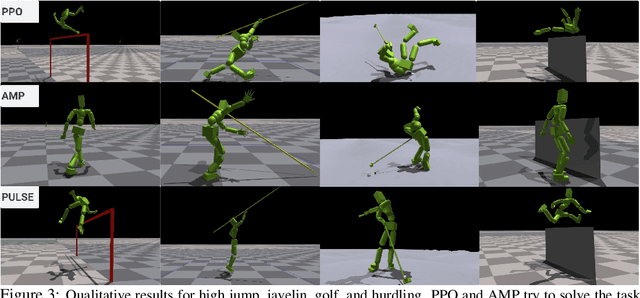

Abstract:We present SMPLOlympics, a collection of physically simulated environments that allow humanoids to compete in a variety of Olympic sports. Sports simulation offers a rich and standardized testing ground for evaluating and improving the capabilities of learning algorithms due to the diversity and physically demanding nature of athletic activities. As humans have been competing in these sports for many years, there is also a plethora of existing knowledge on the preferred strategy to achieve better performance. To leverage these existing human demonstrations from videos and motion capture, we design our humanoid to be compatible with the widely-used SMPL and SMPL-X human models from the vision and graphics community. We provide a suite of individual sports environments, including golf, javelin throw, high jump, long jump, and hurdling, as well as competitive sports, including both 1v1 and 2v2 games such as table tennis, tennis, fencing, boxing, soccer, and basketball. Our analysis shows that combining strong motion priors with simple rewards can result in human-like behavior in various sports. By providing a unified sports benchmark and baseline implementation of state and reward designs, we hope that SMPLOlympics can help the control and animation communities achieve human-like and performant behaviors.
A Local Appearance Model for Volumetric Capture of Diverse Hairstyle
Dec 14, 2023



Abstract:Hair plays a significant role in personal identity and appearance, making it an essential component of high-quality, photorealistic avatars. Existing approaches either focus on modeling the facial region only or rely on personalized models, limiting their generalizability and scalability. In this paper, we present a novel method for creating high-fidelity avatars with diverse hairstyles. Our method leverages the local similarity across different hairstyles and learns a universal hair appearance prior from multi-view captures of hundreds of people. This prior model takes 3D-aligned features as input and generates dense radiance fields conditioned on a sparse point cloud with color. As our model splits different hairstyles into local primitives and builds prior at that level, it is capable of handling various hair topologies. Through experiments, we demonstrate that our model captures a diverse range of hairstyles and generalizes well to challenging new hairstyles. Empirical results show that our method improves the state-of-the-art approaches in capturing and generating photorealistic, personalized avatars with complete hair.
Drivable Avatar Clothing: Faithful Full-Body Telepresence with Dynamic Clothing Driven by Sparse RGB-D Input
Oct 11, 2023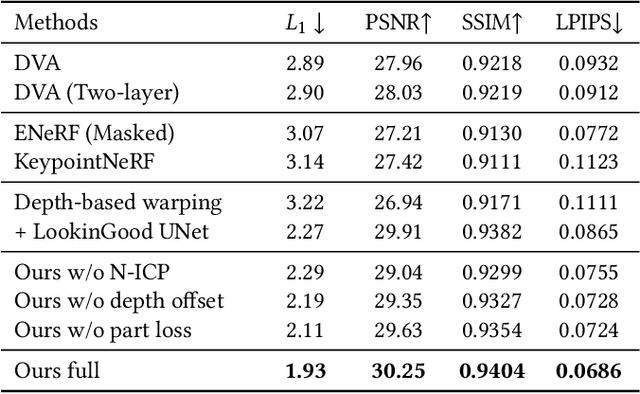
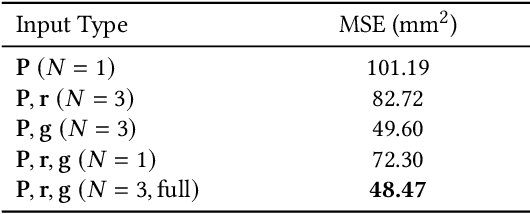

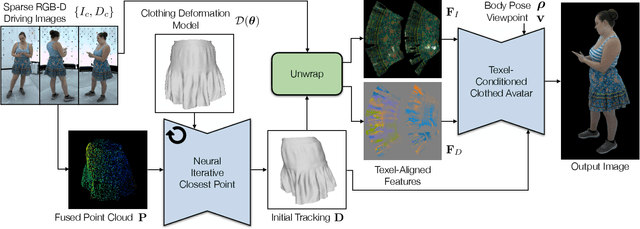
Abstract:Clothing is an important part of human appearance but challenging to model in photorealistic avatars. In this work we present avatars with dynamically moving loose clothing that can be faithfully driven by sparse RGB-D inputs as well as body and face motion. We propose a Neural Iterative Closest Point (N-ICP) algorithm that can efficiently track the coarse garment shape given sparse depth input. Given the coarse tracking results, the input RGB-D images are then remapped to texel-aligned features, which are fed into the drivable avatar models to faithfully reconstruct appearance details. We evaluate our method against recent image-driven synthesis baselines, and conduct a comprehensive analysis of the N-ICP algorithm. We demonstrate that our method can generalize to a novel testing environment, while preserving the ability to produce high-fidelity and faithful clothing dynamics and appearance.
Simulation and Retargeting of Complex Multi-Character Interactions
May 31, 2023Abstract:We present a method for reproducing complex multi-character interactions for physically simulated humanoid characters using deep reinforcement learning. Our method learns control policies for characters that imitate not only individual motions, but also the interactions between characters, while maintaining balance and matching the complexity of reference data. Our approach uses a novel reward formulation based on an interaction graph that measures distances between pairs of interaction landmarks. This reward encourages control policies to efficiently imitate the character's motion while preserving the spatial relationships of the interactions in the reference motion. We evaluate our method on a variety of activities, from simple interactions such as a high-five greeting to more complex interactions such as gymnastic exercises, Salsa dancing, and box carrying and throwing. This approach can be used to ``clean-up'' existing motion capture data to produce physically plausible interactions or to retarget motion to new characters with different sizes, kinematics or morphologies while maintaining the interactions in the original data.
NeuWigs: A Neural Dynamic Model for Volumetric Hair Capture and Animation
Dec 08, 2022



Abstract:The capture and animation of human hair are two of the major challenges in the creation of realistic avatars for the virtual reality. Both problems are highly challenging, because hair has complex geometry and appearance, as well as exhibits challenging motion. In this paper, we present a two-stage approach that models hair independently from the head to address these challenges in a data-driven manner. The first stage, state compression, learns a low-dimensional latent space of 3D hair states containing motion and appearance, via a novel autoencoder-as-a-tracker strategy. To better disentangle the hair and head in appearance learning, we employ multi-view hair segmentation masks in combination with a differentiable volumetric renderer. The second stage learns a novel hair dynamics model that performs temporal hair transfer based on the discovered latent codes. To enforce higher stability while driving our dynamics model, we employ the 3D point-cloud autoencoder from the compression stage for de-noising of the hair state. Our model outperforms the state of the art in novel view synthesis and is capable of creating novel hair animations without having to rely on hair observations as a driving signal. Project page is here https://ziyanw1.github.io/neuwigs/.
Dressing Avatars: Deep Photorealistic Appearance for Physically Simulated Clothing
Jun 30, 2022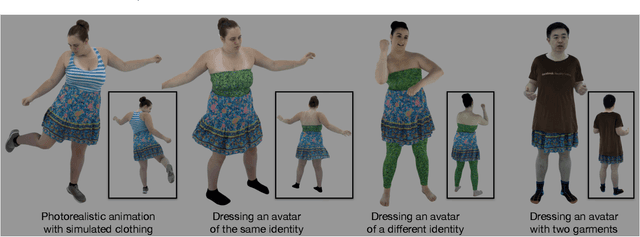
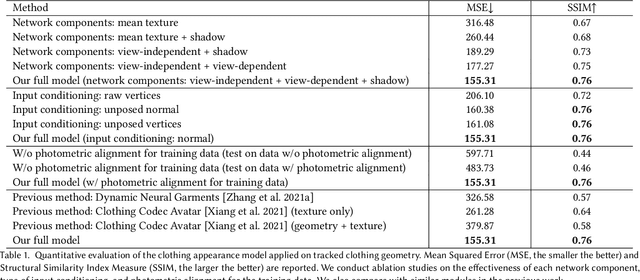

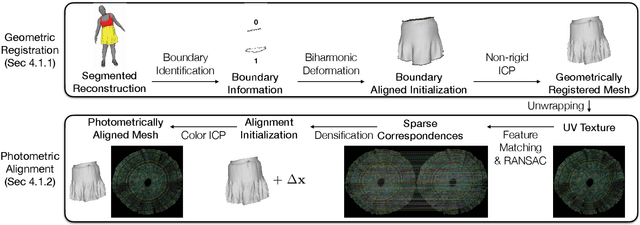
Abstract:Despite recent progress in developing animatable full-body avatars, realistic modeling of clothing - one of the core aspects of human self-expression - remains an open challenge. State-of-the-art physical simulation methods can generate realistically behaving clothing geometry at interactive rate. Modeling photorealistic appearance, however, usually requires physically-based rendering which is too expensive for interactive applications. On the other hand, data-driven deep appearance models are capable of efficiently producing realistic appearance, but struggle at synthesizing geometry of highly dynamic clothing and handling challenging body-clothing configurations. To this end, we introduce pose-driven avatars with explicit modeling of clothing that exhibit both realistic clothing dynamics and photorealistic appearance learned from real-world data. The key idea is to introduce a neural clothing appearance model that operates on top of explicit geometry: at train time we use high-fidelity tracking, whereas at animation time we rely on physically simulated geometry. Our key contribution is a physically-inspired appearance network, capable of generating photorealistic appearance with view-dependent and dynamic shadowing effects even for unseen body-clothing configurations. We conduct a thorough evaluation of our model and demonstrate diverse animation results on several subjects and different types of clothing. Unlike previous work on photorealistic full-body avatars, our approach can produce much richer dynamics and more realistic deformations even for loose clothing. We also demonstrate that our formulation naturally allows clothing to be used with avatars of different people while staying fully animatable, thus enabling, for the first time, photorealistic avatars with novel clothing.
HVH: Learning a Hybrid Neural Volumetric Representation for Dynamic Hair Performance Capture
Dec 19, 2021

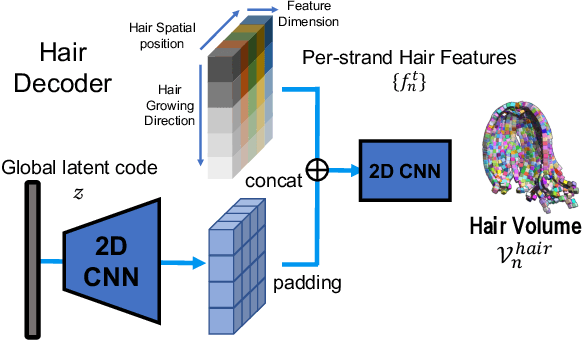

Abstract:Capturing and rendering life-like hair is particularly challenging due to its fine geometric structure, the complex physical interaction and its non-trivial visual appearance.Yet, hair is a critical component for believable avatars. In this paper, we address the aforementioned problems: 1) we use a novel, volumetric hair representation that is com-posed of thousands of primitives. Each primitive can be rendered efficiently, yet realistically, by building on the latest advances in neural rendering. 2) To have a reliable control signal, we present a novel way of tracking hair on the strand level. To keep the computational effort manageable, we use guide hairs and classic techniques to expand those into a dense hood of hair. 3) To better enforce temporal consistency and generalization ability of our model, we further optimize the 3D scene flow of our representation with multi-view optical flow, using volumetric ray marching. Our method can not only create realistic renders of recorded multi-view sequences, but also create renderings for new hair configurations by providing new control signals. We compare our method with existing work on viewpoint synthesis and drivable animation and achieve state-of-the-art results. Please check out our project website at https://ziyanw1.github.io/hvh/.
 Add to Chrome
Add to Chrome Add to Firefox
Add to Firefox Add to Edge
Add to Edge